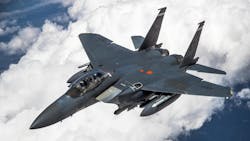Boeing to install electronic warfare (EW) systems aboard U.S. Air Force F-15 jet fighter aircraft fleet
WRIGHT-PATTERSON AFB, Ohio – electronic warfare (EW) avionics experts at the Boeing Co. will produce EW avionics for the U.S. Air Force F-15 jet fighter fleet that will help protect the combat aircraft from radar-guided missiles.
Officials of the Air Force Life Cycle Management Center at Wright-Patterson Air Force Base, Ohio, announced a $55.4 million order in late September to Boeing Defense, Space & Security segment in St. Louis for the F-15's Eagle Passive Active Warning and Survivability System (EPAWSS) low rate initial production.
The EPAWSS provides the Air Force F-15 jet fighter fleet with EW technology to make the most of mission effectiveness and survivability, BAE Systems officials say. It provides offensive and defensive EW options for the pilot.
Boeing is the original manufacturer of the 1970s-vintage F-15 Eagle jet fighter, and the BAE Systems Electronic Systems segment in Nashua, N.H., designs and builds the EPAWSS. McDonnell Douglas Corp. designed the aircraft and manufactured it from 1976 to 1996. Boeing bought McDonnell Douglas in 1996 and continued F-15 production through 2019.
EPAWSS also will be part of the avionics suite of the next-generation F-15EX, which is based on the F-15 Advanced Eagle that Boeing is building for the air forces of Qatar and Saudi Arabia, which has a fly-by-wire flight control system, digital electronic warfare (EW) suite, an infrared search and track (IRST) system, and the Raytheon APG-63(v)3 active electronically scanned array (AESA) radar.
Boeing provides planning, design development, integration, testing, and risk reduction activities for the F-15 EPAWSS program, while partner BAE Systems provides EPAWSS design and production.
EPAWSS offers integrated radar warning, geo-location, situational awareness, and self-protection to detect and defeat enemy aircraft, air-to-air missiles, as well as surface-to-air missiles amid dense electronic signals in contested airspace. Its electronic countermeasures enable the F-15 to penetrate enemy air defenses.
The all-digital EPAWSS is smaller than previous F-15 EW systems, and offers improved reliability and maintainability. The Air Force and Boeing chose BAE Systems to design and build the EPAWSS last year to replace the F-15's ALQ-135 EW suite.
Delays in building and deploying the Lockheed Martin F-35 have encouraged Air Force leaders to extend the service life of the F-15 fleet beyond 2040, with upgrades involving new active electronically scanned array (AESA) radars, new EW sensors and processors, and new cockpit displays.
The F-15EX carries more weapons than similar fighter aircraft, and will be able to launch hypersonic weapons that are as large as 22 feet long weight as much as 7,000 pounds, Boeing officials say. The F-15EX also is following the U.S. Department of Defense (DOD) DevSecOps initiative to develop secure, flexible, and agile software and an open-systems avionics architecture.
The F-15EX will be a large, powerful, non-stealthy, twin-engine jet fighter able to carry a large air-superiority weapons payload. The plane will be able to carry as many as 22 AIM-9X Sidewinder and AMRAAM medium range air-to-air missiles.
It also will have a substantially more powerful mission computer than all existing versions of the F-15, new cockpit displays, a digital backbone, infrared search and track (IRST) system, the Raytheon APG-63(v)3 active electronically scanned array (AESA) radar, and the Eagle Passive Active Warning Survivability System (EPAWSS) -- an electronic warfare and threat identification system.
The F-15EX also will have terrain-following radar to enable the pilot to fly at a very low altitude following cues displayed on a heads up display. The targeting pod contains a laser designator and a tracking system with a 10-mile range. The plane also will have as many as 11 underwing weapons stations and digital Joint Helmet-Mounted Cueing Systems. The original F-15 jet fighter began development in 1967, and entered service with the U.S. Air Force in 1976.
On this EPAWSS order Boeing will do the work at Robins Air Force Base, Ga., and should be finished by December 2026. For more information contact Boeing Defense, Space & Security online at www.boeing.com/company/about-bds, BAE Systems Electronic Systems at www.baesystems.com, or the Air Force Life Cycle Management Center at www.aflcmc.af.mil.
About the Author
John Keller
Editor-in-Chief
John Keller is the Editor-in-Chief, Military & Aerospace Electronics Magazine--provides extensive coverage and analysis of enabling electronics and optoelectronic technologies in military, space and commercial aviation applications. John has been a member of the Military & Aerospace Electronics staff since 1989 and chief editor since 1995.
